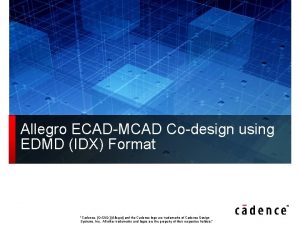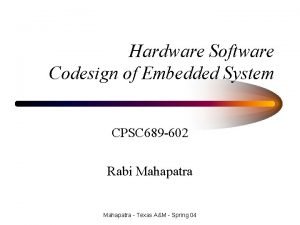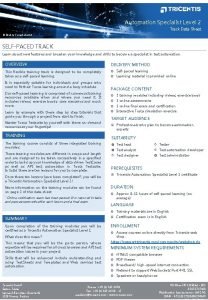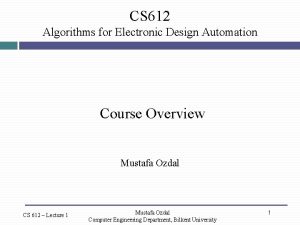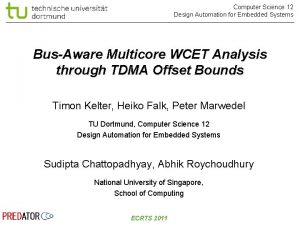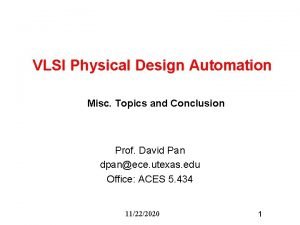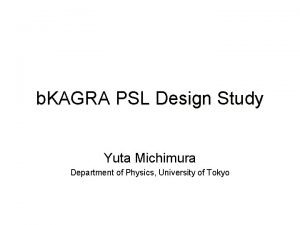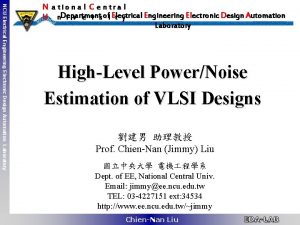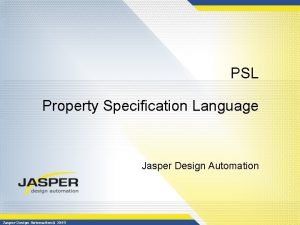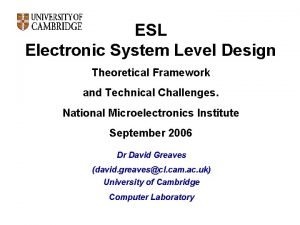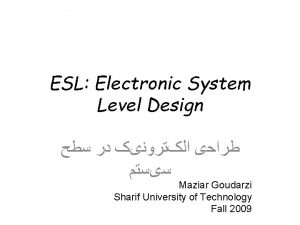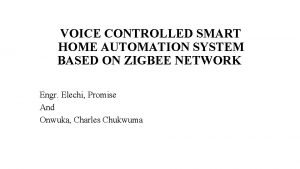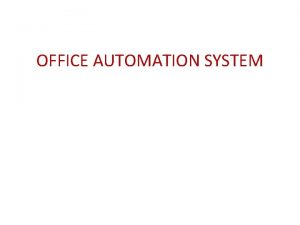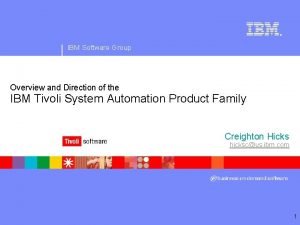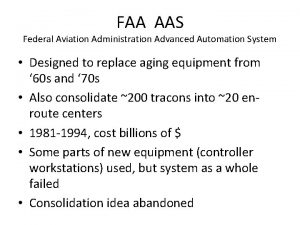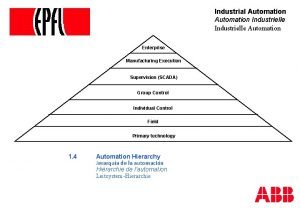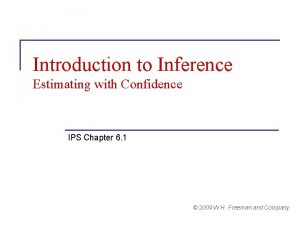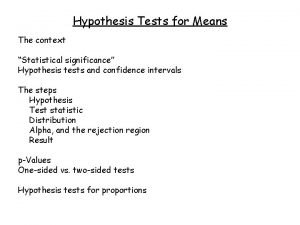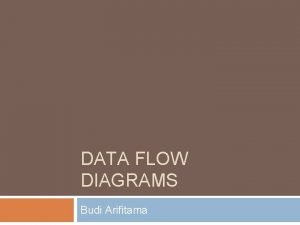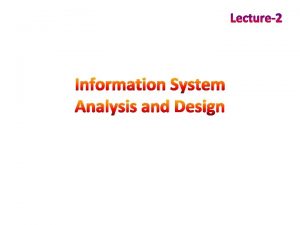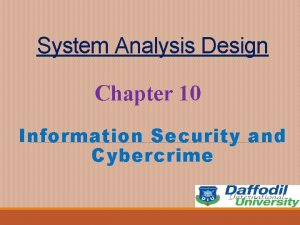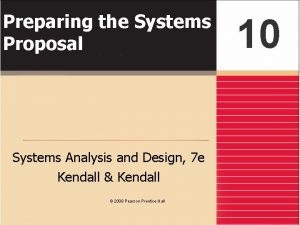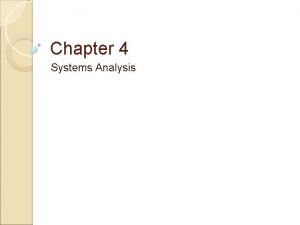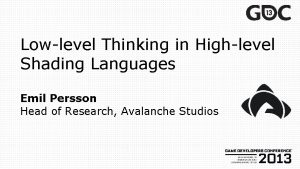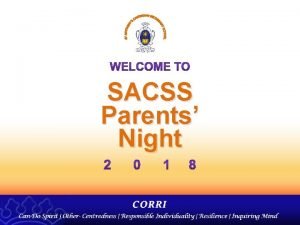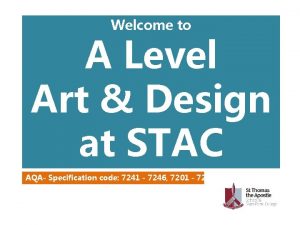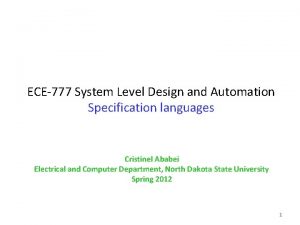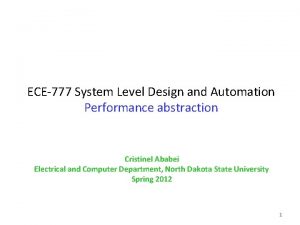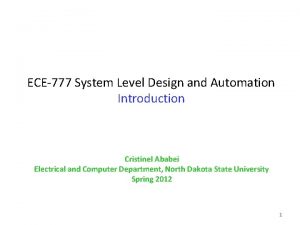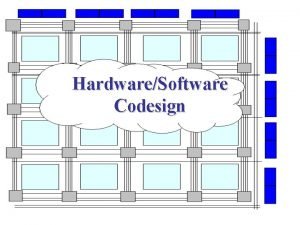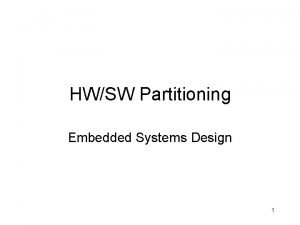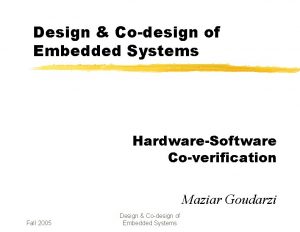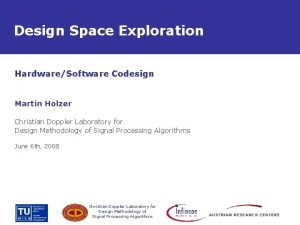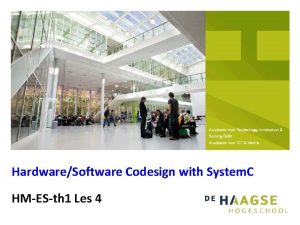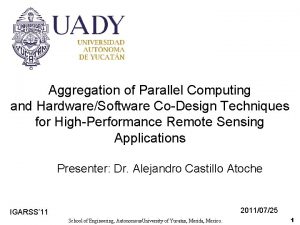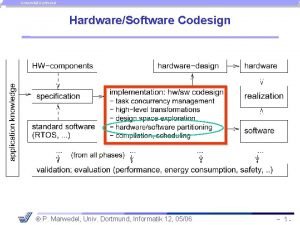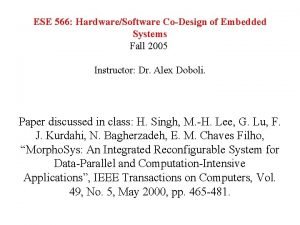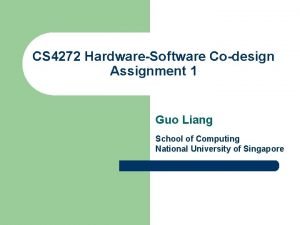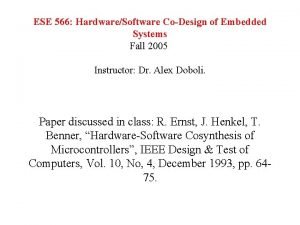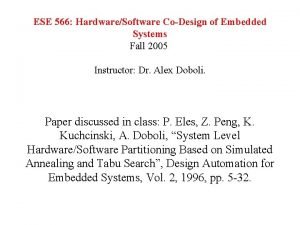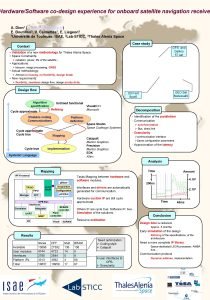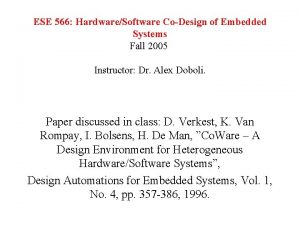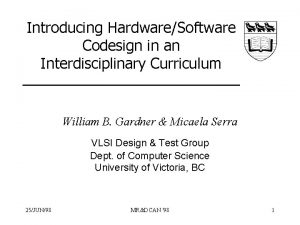ECE777 System Level Design and Automation HardwareSoftware Codesign










































- Slides: 42

ECE-777 System Level Design and Automation Hardware/Software Co-design Cristinel Ababei Electrical and Computer Department, North Dakota State University Spring 2012 1

Simplified design flow: part in HW, part in SW Decision based on hardware/software partitioning, a special case of hardware/software co-design. HW/SW Co-design • Task concurrency management • High-level transformations • Design space exploration • HW/SW partitioning • Compilation, scheduling co 2

HW/SW Co-design • HW/SW Co-design means the design of a specialpurpose system composed of a few application-specific ICs that cooperate with software procedures on general-purpose processors (1994) • HW/SW Co-design means meeting system-level objectives by exploiting the synergism of hardware and software through their concurrent design (1997) • HW/SW Co-design tries to increase the predictability of embedded system design by providing analysis methods that tell designers if a system meets its performance, power, and size goals and synthesis methods that let designers rapidly evaluate many potential design methodologies (2003) • It moved from an emerging discipline (early ‘ 90 s) to a mainstream technology (today) 3

Outline • HW/SW Co-design – Hardware/Software partitioning – Scheduling – Hardware exploration – Software optimization • HW/SW Co-synthesis 4

Informal Specification System Model System Simulation Design flow Algorithmic Design Hardware/Software Partitioning Partitioned Model Schedule System synthesis Software Model Refine Partitioned Model & Sch. Communication Synthesis HW/SW Co-simulation Hardware Model Compilation Synthesis Binary Exec. Model Gate-level Model Emulate or Prototype Fabrication 5

Design objectives • • Cost Performance Power Area Scalability and reusability Fault tolerance Thermal characteristics … 6

Hardware/Software Partitioning • No need to consider special purpose hardware in the long run? • Specialized hardware needed for • Low power operation • High performance • Increasing application complexity • “By the time MPEG-n can be implemented in software, MPEG-n+1 has been invented” [de Man] 7

Partitioning: Levels of Abstractions • Low level: at the register transfer (RTL) level, at the netlist level – split a digital circuit and map it to several devices (FPGAs, ASICs) – system parameters are relatively well-known (area, delay) • High level: at the system level – comparison of design alternatives mandatory (design space exploration) – system parameters are unknown – importance of estimation (analysis, simulation, rapid prototyping) 8

Hardware/Software Partitioning • Decompose (i. e. , partition) the function F of the system into N sub-functions F 1, F 2, F 3 … FN F • Decompose the constraints and design objectives of the system into sub-constraints {F 1, F 2, F 3 … Fn} and design sub-objectives • Cluster F 1, F 2, F 3, …, Fn into M … partitions to run on M PEs (can be all processors): aka mapping • Optimize (usually minimization) P 1 P 2 P 3 … a cost function c(M) PM 9

General Partitioning Methods • Exact methods: – Enumeration – Integer Linear Programs (ILP) • Heuristic methods: – Constructive methods • Random mapping • Hierarchical clustering – Iterative methods • Kernighan-Lin Algorithm • Simulated Annealing • Evolutionary Algorithms (EA) 10

Integer Programming Models 11

Example 12

Remarks • Maximizing the cost function can be done by setting C‘=-C • Integer programming is NP-complete • In practice, running times can increase exponentially with the size of the problem, but problems of some thousands of variables can still be solved with commercial solvers, depending on the size and structure of the problem • IP models can be a good starting point for modeling, even if in the end heuristics have to be used to solve them 13

ILP for partitioning 14

ILP for partitioning 15

Example of HW/SW partitioning: COdesign to. OL (COOL) • Inputs to COOL: 1. Target technology : available HW platform components 2. Design constraints : required throughput, latency, maximum memory size or maximum area for ASIC 3. Required behavior : required overall behavior. Hierarchical task graphs Specification Mapping Processor P 1 Processor P 2 Hardware [Niemann, Hardware/Software Co-Design for Data Flow Dominated Embedded Systems, Kluwer Academic 16 Publishers, 1998 (Comprehensive mathematical model)]

Steps of the COOL partitioning algorithm 1. Translation of the behavior into an internal graph model 2. Translation of the behavior of each node from VHDL into C 3. Compilation • All C programs compiled for the target processor, • Computation of the resulting program size, • Estimation of the resulting execution time (simulation input data might be required) 4. Synthesis of hardware components: • leaf nodes, application-specific hardware is synthesized. • High-level synthesis sufficiently fast. 5. Flattening of the hierarchy: • Granularity used by the designer is maintained. • Cost and performance information added to the nodes. • Precise information required for partitioning is pre-computed 6. Generating and solving a mathematical model of the optimization problem: • Integer programming IP model for optimization. Optimal with respect to the cost function (approximates communication time) 17

Steps of the COOL partitioning algorithm 7. Iterative improvements: Adjacent nodes mapped to the same hardware component are now merged. 8. Interface synthesis: After partitioning, the glue logic required for interfacing processors, application-specific hardware and memories is created. 18

General Partitioning Methods • Exact methods: – enumeration – Integer Linear Programs (ILP) • Heuristic methods: – constructive methods • random mapping • hierarchical clustering – iterative methods • Kernighan-Lin Algorithm • Simulated Annealing • Evolutionary Algorithms (EA) 19

Constructive methods • A constructive approach: – performed in several iterations – with final goal to group a set of objects into partitions according to some measure of closeness • Bottom up approach – each object initially belongs to its own cluster, – and clusters are then gradually merged until the desired partitioning is found – does not require a global view of the system – relies only on local relations between objects (closeness metrics) 20

Example: Hierarchical Clustering 21

Iterative methods • Based on a design space exploration which is guided by an objective function that reflects the global quality of the partitioning – a starting solution is modified iteratively, by passing from one candidate solution to another – passing is based on evaluations of an objective function • Iterative algorithms differ from one another primarily in the ways in which they modify the partition and ways in which they accept or reject bad modifications 22

Example: Simple Greedy Heuristic 23

Example: Kernighan-Lin (Min-cut) Heuristic • Problem with Greedy Approach – Simple greedy heuristic can get stuck in a local minimum Cost function Goal of any optimization algorithm is to find: global maxima, or global minima • Improved algorithm (Kernighan-Lin): – Algorithm allows moves between clusters that may not improve the cost – this allows the algorithm to escape from local optima 24

Outline • HW/SW Co-design – Hardware/Software partitioning – Scheduling – Hardware exploration – Software optimization • HW/SW Co-synthesis 25

Informal Specification System Model System Simulation Design flow Algorithmic Design Hardware/Software Partitioning Partitioned Model Schedule System synthesis Software Model Refine Partitioned Model & Sch. Communication Synthesis HW/SW Co-simulation Hardware Model Compilation Synthesis Binary Exec. Model Gate-level Model Emulate or Prototype Fabrication 26

Scheduling • Scheduling is to obtain an execution sequence such that all dependencies are obeyed 3 F 1 – A deadline D for the entire schedule – An execution time Ti for each Fi F 4 • Approaches F 6 – Static • During design time the schedule is fixed (the common case) – Dynamic • During execution time, the schedule is determined (reconfigurable computing) • Scheduling of – Computation – Communication F 3 3 F 2 6 2 F 5 F 7 3 1 F 8 3 P 1: F 1 F 2 F 8 P 2: F 4 F 5 P 3: F 3 F 6 P 4: F 7 27 4

Scheduling v 1 v 2 v 3 e 3 v 5 v 6 v 4 e 4 v 7 Processor p 1 FIR 2 ASIC h 1 v 8 Communication channel c 1 v 9 v 10 v 11 FIR 2 on h 1 p 1 c 1 . . . v 3 4 . . . v 7 8 . . . e 3 4 or. . . v 4 3 or. . . v 8 7 or. . . e 4 3 t t t 28

Scheduling: precedence constraints • For all nodes vi 1 and vi 2 that are potentially mapped to the same processor or hardware component instance, introduce a binary decision variable bi 1, i 2 with bi 1, i 2=1 if vi 1 is executed before vi 2 and = 0 otherwise. Define constraints of the type (end-time of vi 1) (start time of vi 2) if bi 1, i 2=1 and (end-time of vi 2) (start time of vi 1) if bi 1, i 2=0 • Ensure that the schedule for executing operations is consistent with the precedence constraints in the task graph • Approach just fixes the order of execution and avoids the complexity of computing start times during optimization • Other constraints – Timing constraints: These constraints can be used to guarantee that certain time constraints are met 29

Example: Scheduling using ILP • HW types H 1, H 2 and H 3 with costs of 20, 25, and 30. • Processors of type P. • Tasks T 1 to T 5. • Execution times: T 1 2 3 4 5 H 1 20 H 2 H 3 20 12 12 20 P 100 10 10 100 30

Operation assignment constraints (1) T 1 2 3 4 5 H 1 20 H 2 H 3 20 12 12 20 P 100 10 10 100 X 1, 1+Y 1, 1=1 (task 1 mapped to H 1 or to P) X 2, 2+Y 2, 1=1 X 3, 3+Y 3, 1=1 X 4, 3+Y 4, 1=1 X 5, 1+Y 5, 1=1 31

Operation assignment constraints (2) • Assume types of tasks are ℓ =1, 2, 3, 3, and 1. ℓ L, i: T(vi)=cℓ, k KP: NYℓ, k Yi, k Functionality 3 to be implemented on processor if node 4 is mapped to it. 32

Notation used • Index set I denotes task graph nodes • Index set L denotes task graph node types e. g. square root, DCT or FFT • Index set KH denotes hardware component types. e. g. hardware components for the DCT or the FFT • Index set J of hardware component instances • Index set KP denotes processors All processors are assumed to be of the same type 33

Other equations • Time constraints leading to: Application specific hardware required for time constraints under 100 time units. T 1 2 3 4 5 H 1 20 H 2 H 3 20 12 12 20 P 100 10 10 100 Cost function: C=20 #(H 1) + 25 #(H 2) + 30 # (H 3) + cost(processor) + cost(memory) 34

Result • For a time constraint of 100 time units and cost(P)<cost(H 3): T 1 2 3 4 5 H 1 20 H 2 H 3 20 12 12 20 P 100 10 10 100 Solution (educated guessing) : T 1 H 1 T 2 H 2 T 3 P T 4 P T 5 H 1 35

Outline • HW/SW Co-design – Hardware/Software partitioning – Scheduling – Hardware exploration – Software optimization • HW/SW Co-synthesis 36

Hardware exploration. Software optimization. Hardware Components Concept Specification Software Components HW/SW Partitioning Hardware n sig e …) D , t ou y a s, L i s e nth y (S De sig n Estimation - (Com pila Exploration tio n, …) Software Validation and Evaluation (area, power, performance, …) 37

Hardware exploration. Software optimization. • Hardware exploration – Architecture Description Language (ADL) driven processor memory exploration. EXPRESSION toolkit: • http: //www. ics. uci. edu/~express/index. htm – Communication architecture exploration (point to point, bus, hierarchical bus, bus matrix, No. C, etc. ) – More info: • http: //www. engr. colostate. edu/~sudeep/teaching/ppt/lec 10_hw_explore. ppt • Software optimization – – Floating-point, fixed-point conversions Loop transformations, Array folding, Function inlining Compiler optimizations (low energy), exploiting memory hierarchies More info: • http: //www. engr. colostate. edu/~sudeep/teaching/ppt/lec 11_sw_optimiz ations. ppt 38

Outline • HW/SW Co-design – Hardware/Software partitioning – Scheduling – Hardware exploration – Software optimization • HW/SW Co-synthesis 39

From HW/SW Co-design to HW/SW Co-synthesis! • Early approaches: HW/SW partitioning would be done first and then HW/SW blocks would be synthesized separately • Ideally system synthesis would do HW/SW partitioning, mapping, and scheduling in a unified fashion – very difficult • Design space exploration (estimation and refinement) would also be done in a unified fashion; by working at the same time with both HW and SW modules Co-synthesis • Key: communication models 40

Co-synthesis • Co-synthesis: Synthesize the software, hardware and interface implementation in a unified fashion. This is done concurrently with as much interaction as possible between the three implementations. 41

Tools • POLIS – a framework for HW/SW co-design – http: //embedded. eecs. berkeley. edu/research/hsc • Hardware exploration: EXPRESSION toolkit – http: //www. ics. uci. edu/~express/index. htm • COOL - a HW/SW co-design tool – http: //ls 12 -www. cs. tudortmund. de/research/activities/codesign/cool/index. html • More tools: – http: //www. cs. hongik. ac. kr/~dspark/codesignlink. htm 42
 Ecad mcad flow
Ecad mcad flow Hardware software codesign in embedded systems
Hardware software codesign in embedded systems Automation specialist level 2
Automation specialist level 2 What is input and output design
What is input and output design Cs 612
Cs 612 Design automation for embedded systems
Design automation for embedded systems Optima design automation
Optima design automation Vlsi physical design automation
Vlsi physical design automation Jasper design automation
Jasper design automation Electrical design automation
Electrical design automation Property specification language
Property specification language Dut
Dut Electronic system level design
Electronic system level design User interface design in system analysis and design
User interface design in system analysis and design Dialogue design in system analysis and design
Dialogue design in system analysis and design Conclusion of home automation
Conclusion of home automation Oas information system
Oas information system Ibm tivoli system automation for multiplatforms
Ibm tivoli system automation for multiplatforms Faaaas
Faaaas Terminal automation system (tas)
Terminal automation system (tas) Supervision industrielle
Supervision industrielle Iphmis
Iphmis Significance and confidence level
Significance and confidence level Confidence level and significance level
Confidence level and significance level Confidence level and significance level
Confidence level and significance level Data flow diagram for employee management system
Data flow diagram for employee management system Properties of a system in system analysis and design
Properties of a system in system analysis and design System security in system analysis and design
System security in system analysis and design Title proposal for system analysis and design
Title proposal for system analysis and design Feasibility matrix example
Feasibility matrix example Problem definition in system analysis and design
Problem definition in system analysis and design Open closed and isolated system
Open closed and isolated system Digestive system respiratory system and circulatory system
Digestive system respiratory system and circulatory system Molecular level vs cellular level
Molecular level vs cellular level Isis protocol
Isis protocol Isis level 1 vs level 2
Isis level 1 vs level 2 Security level 0
Security level 0 Level 1 2 3 questions
Level 1 2 3 questions Thread level parallelism in computer architecture
Thread level parallelism in computer architecture Rcp hlsl
Rcp hlsl Sacss
Sacss Aqa a level art and design
Aqa a level art and design Art and design a level aqa
Art and design a level aqa
